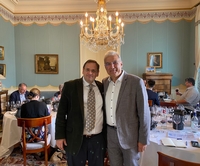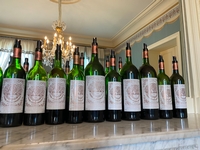I can still recall the disappointment in Jean-René Matignon’s face as rain started to fall towards the end of the 2006 harvest. “This could have been as good as 2005,” he told me regretfully. Nearly 16 years later, when tasting the vintage at Château Pichon Longueville Baron in a vertical of no less than 37 vintages, the wine tasted as one could expect: not as good as the 2005, but pretty good,

proving the point that excellent terroir from an estate like Château Pichon Longueville Baron can shine over time, even in a less than “great” vintage.
In May this year, the estate invited me to join a special
Au Revoir morning tasting and lunch featuring vintages that spanned Jean-René’s career with the château. We then enjoyed magnums of 1959 and 1961 over lunch (of course, pre-dating his arrival at the estate).
The universally high quality of the wines experienced testifies not only to the excellence of the terroir, but also to the talent of Jean-René and his team.
On two occasions earlier this century, Jean-René joined me for “winemaker dinners” that I had organized in Germany and in Washington D.C., where participants appreciated his frank affability and informative feedback when they posed questions. In my experience as a journalist and as a wine events organizer, I came to appreciate and admire Jean-René as both a professional and kind man, one who exudes passion and love for wine. He and his team blazed a trail to making powerful Pauillac wines with refinement, increasing the amount of Cabernet Sauvignon in the blends, reducing the percentage of the
grand vin drawn from the total of the estate’s fruit, and increasing the percentage of new oak. Of 72 hectares owned by the estate today, the first wine is made primarily from older vines growing on a prized 40-hectare plateau of gravel beds with poor soils that force vines to go deep into the ground. But that was not the case in the 1990s.
Grapes from Merlot vines west of the plateau that had previously been used to make the
grand vin in the 1990s now make more of the second wine, Les Tourelles de Longueville, a blend with 65% Merlot that ages in 30% new oak – and is meant for earlier consumption. Since 2012, even fewer estate grapes were used to craft Pichon Baron, with the introduction of Les Griffons de Pichon Baron, a
second second wine with more Cabernet in the blend, crafted from parcels “geographically and in personality closer to the character of Pichon Baron,” Seely explained.
The resulting increase of Cabernet Sauvignon in the blend of the
grand vin – from about 60 percent Cabernet Sauvignon and 40 percent Merlot in the 1990s, to an average 80-20 blend today – lends a more foreboding aspect to Pichon Baron.
Over lunch both older vintages showed well. Seely recalled having tasted the “beautiful” 1959 – essentially made from vines in the 40-hectare plateau. While the intention is not to “copy” that older wine, it is to make wines that best reflect the “soul of the place,” Seely explained. When we got to the 2005 vintage for the vertical, it marked a “turning point” for quality and quantity. “It showed how great the wine can be, and it ensured that I would keep my job given the high-risk strategy of making half as much wine as we had before,” Seely stressed.
But on this occasion, the 1961 outgunned the excellent 1959, with impeccable pristine refinement as well as power: it was a
tour de force and one of the best older Bordeaux I have had in over 20 years of tasting Bordeaux wines. In short, I give the 1961 magnum
100 points, and to the 1959,
97 points.
10 Tasting Notes:
1985 – What lovely elegance, tobacco leaf and Havana cigar with truffle! This wine – cropped at over 60 hectoliters per hectare – simply seduced with vivid notions of baked plum and spice. I could see why some preferred the 1986, and

how it could turn out better later. For now, 1985 gets the nod.
96 (Drink to 2040)
1990 – Compared to the 1989, the 1990 is leafier, earthier, more evolved, but I really liked the smooth and creamy palate, with almost custard-like sweetness even if thoroughly dry, thoroughly Pauillac in tobacco expressions, depth, and power. However, it has a
slight note of burgeoning rusticity, which the (superior) 1989 did not. Cropped at close to 70 hectoliters per hectare, the harvested grapes were rather large: Merlots picked by 27 September and Cabernets by 16 October, under clear, sunny skies. Like the 1989, 73% Cabernet Sauvignon and 27% Merlot, but with 70% new oak aging for 15 months.
97 (Drink to 2040)
1997 – From magnum and one of the most surprisingly yummy wines: suave, cooler blue fruit, powdered chocolate, cherry and plum. Sure, the 1997s were generally overpriced upon release (
en primeur in general) and considered inferior to 1996 and 1995, but the laser precision and linear finish are marked by pure fruit. It lacks the depth and power of the 1996 or especially the 1989, but 1997 is beautiful to enjoy now – and for some years to come.
95 (Drink to 2035)
2000 – One of the top wines of the series, fulfilling the mythical promise that some critics expressed upon release, foremost Robert Parker. Juicy, powerful and balanced, this blend of 70% Cabernet-Sauvignon, 25% Merlot and ... 5% Cabernet Franc was aged in 80% new oak; very well integrated. The wine leaves an impression of being fresh and open-knit, while also dense and powerful. I admire the refined tannin and Burgundian wet stone aspect. Glorious wine, with the potential to gain in complexity.
98 (Drink to 2055)
2003 – Ah, the vintage of the infamous heat wave: the polar opposite of 2002. And while many 2003s do indeed have overripe flavors (sometimes under-ripe, because the heat resulted in stress), many top-notch estates from the cooler northern Médoc excelled, including Pichon Baron. Nearly 20 years later, this blend of 65% Cabernet and 35% Merlot, having aged 15 months in 70% new oak (same blend and aging as in 2002) exudes ripe fruit purity, smooth tannin and good acidity. The terroir (and hard teamwork) proved successful. While not as nuanced and fascinating as the 2000 vintage, a strong showing.
95 (Drink to 2050)
2005 – A great vintage, but too young: it is hard in 2022 to coax aromas from a rather closed nose. And yet, dark chocolate from the Merlots and tobacco from the Cabernet slowly emerge. The palate shows impressive density and power, although some austerity, suggesting a closed phase. Do not underestimate the greatness of the vintage, here and in other top Bordeaux properties. Glorious when tasted from barrel, reflecting ripe grapes that, according to Jean-René, showed
unprecedented sugar concentration and a “very high polyphenol standard,” noticeable in both the color and the tannins. I suspect that the 2005s have some 1986 style structure requiring more time to blossom. A
conservative score for now.
95 (Drink to 2060)
2006 – After the first bottle had a cork issue, the second bottle shined nicely, albeit with somewhat tighter tannins than the 2005, not quite as fine grained, and yet the wine has density and power, with a long yet subtle finish. The wine blends 70% Cabernet-Sauvignon, 28% Merlot and 2% Cabernet Franc, having aged in 80% new oak.
94+ (Drink to 2050)
2016 – Tasting this wonderful vintage of both density and 2005-like structure in May 2022 was too early. And yet, from the get-go, you can sense incredible harmony, depth and density on the palate. The vintage was marked by widely varying weather conditions with a cold, wet winter, a damp spring, and a hot, dry summer. But unlike 2018, 2019 and 2020, 2016 benefitted much more from a long, splendid Indian summer helping the grapes, especially the Cabernets, to reach excellent ripeness levels and powerful, yet very fine tannins. The Merlot from the plateau was harvested from 3-5 October, followed by early-ripening Cabernet Sauvignon in the deep soils of the main terroirs from 10-18 October. The wine blends 85% Cabernet Sauvignon and 15% Merlot, having aged in 80% new oak. Long finish.
96+ (Drink to 2065+)
2018 – A justifiably memorable vintage coming after the “okay” 2017, as 2018 had higher alcohol (14.5%), richer ripeness, and rather high pH levels. Some dubbed it Californian. But as ever, it comes down to location and northern Médoc estates excelled, with the Baron being no exception. Although I prefer the 2016, this is turning out very nicely: luscious, opulent and deep, with distinct expressions of jammy, ripe fruit and classy pencil lead. The old vine Merlot grapes were picked in late September, followed by Cabernets picked in early October; the final blend of 78% Cabernet Sauvignon and 22% Merlot was aged in 80% new oak.
96 (Drink to 2060)